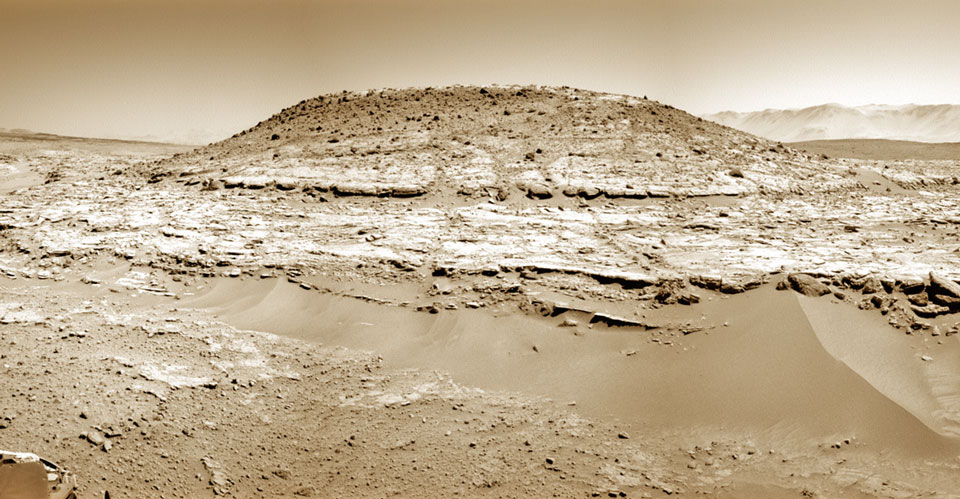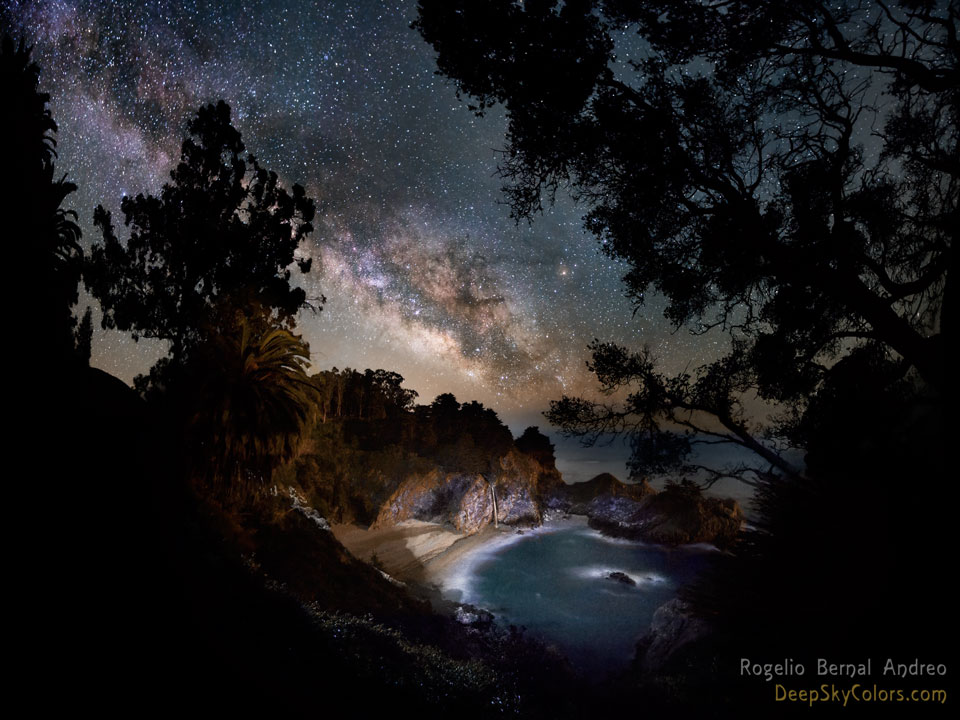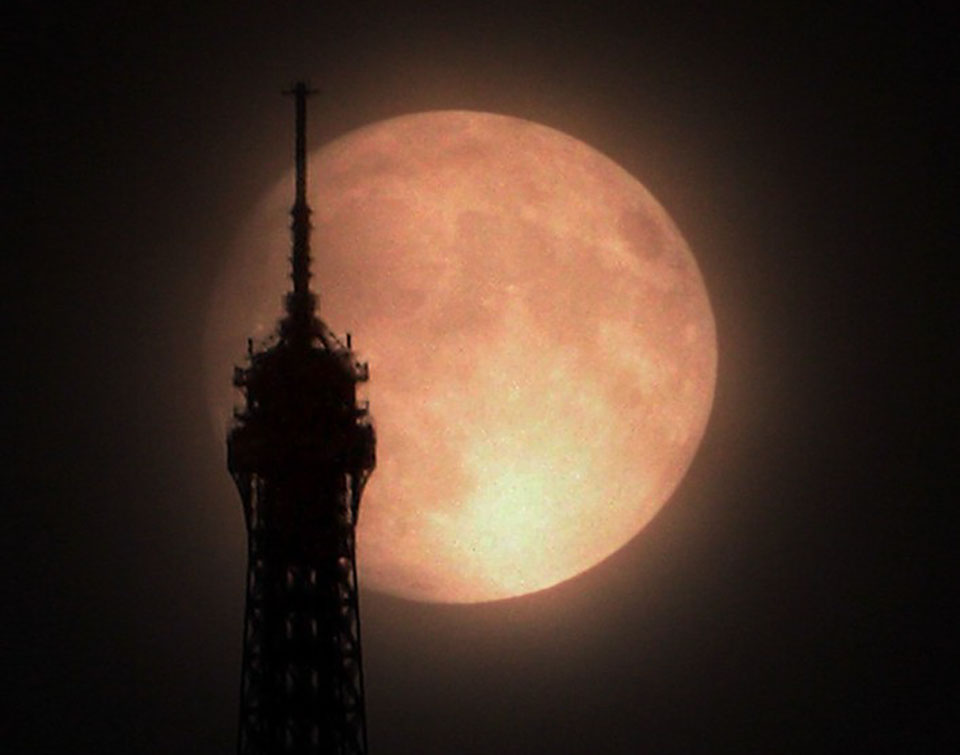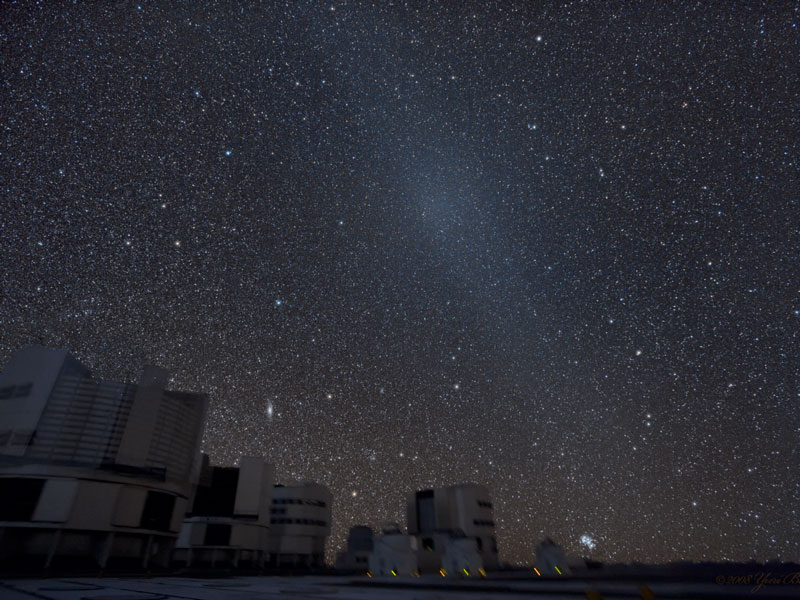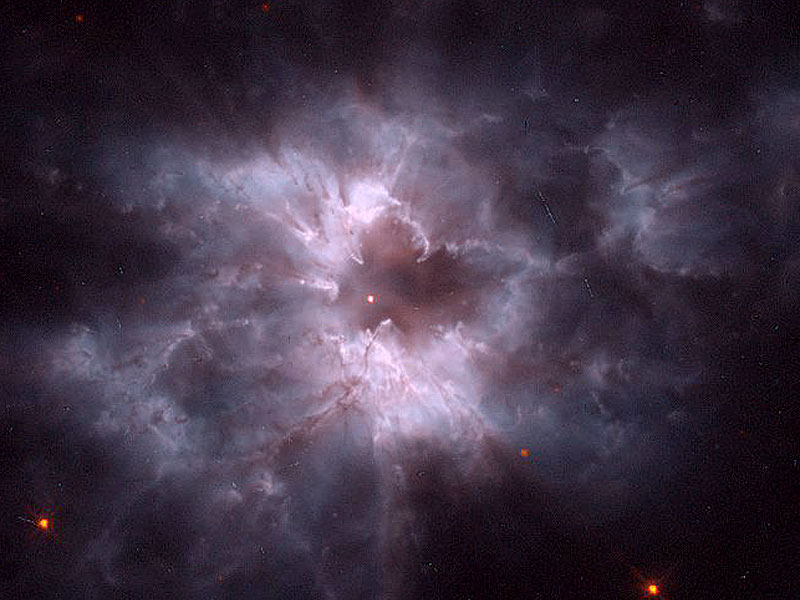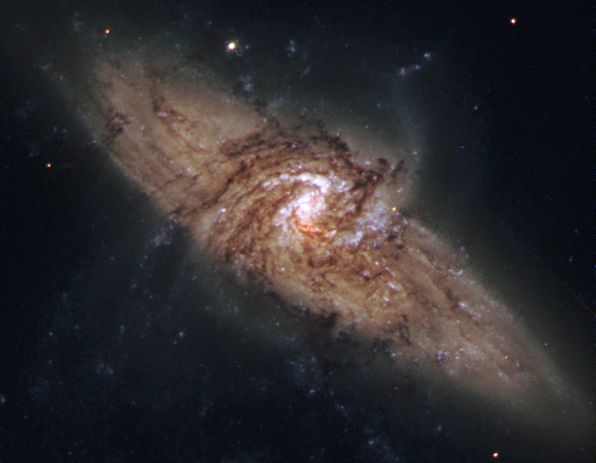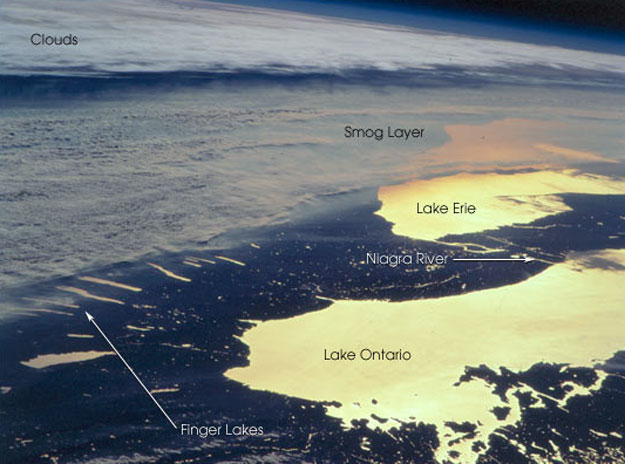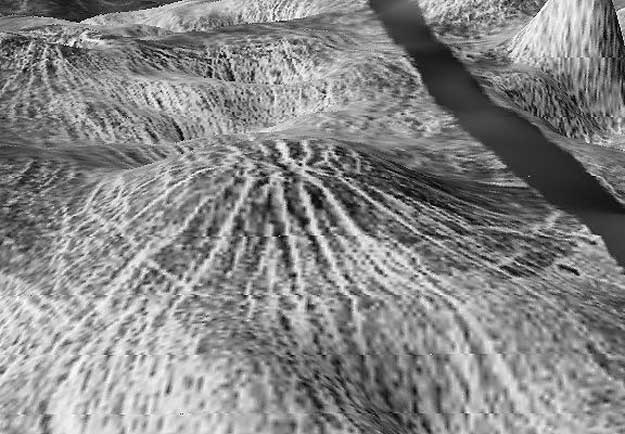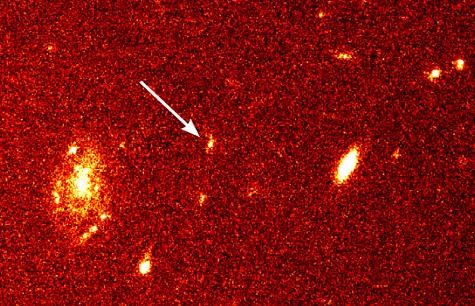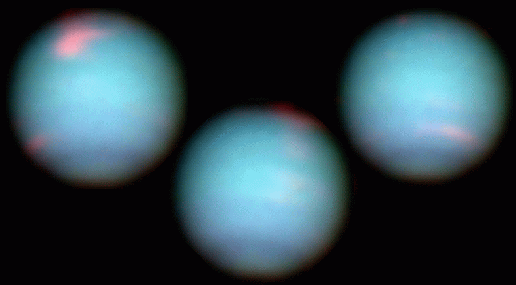| << Previous | Index | Next >> |
2015 Did you ever want to just look through the eyepiece of a large telescope in space? If you could, you would see a sharp view that was diffraction limited. Unaffected by atmospheric blurring that ultimately plagues earthbound observers, the angular resolution of your diffraction limited view would be determined only by the wavelength of light and diameter of the telescope lens or mirror; the larger the diameter, the sharper the image. Still, in this working earth-based snapshot a new active adaptive optics system (MagAO) is being used to cancel out the atmospheric blurring in a visual observation of famous double star system Alpha Centauri. Testing the system at the eyepiece of the 6.5 meter diameter Magellan Clay Telescope at Las Campanas Observatory, astronomer Laird Close is enjoying a historic diffraction limited view (inset) and the wide apparent separation of the close binary star system ... without traveling to low earth orbit.
2014 What has the Curiosity rover come across on Mars? Dubbed Mount Remarkable, the rolling robot has chanced upon this notable 5-meter tall mound during its continuing journey around and, eventually, up 5.5-kilometer high Mt. Sharp. Unsure of the density of the surrounding layered sandstone, the human team on Earth has instructed the car-sized rover on Mars to drill into a rock on the side of Mt. Remarkable to investigate. Quite possibly, water involved in creating the dense sandstone could have helped to support ancient life on the red planet. Mt. Sharp, the unusual central peak of Gale Crater, has a similar base-to-peak height as Earth's Mt. Everest.
2013 To see a vista like this takes patience, hiking, and a camera. Patience was needed in searching out just the right place and waiting for just the right time. A short hike was needed to reach this rugged perch above a secluded cove in Julia Pfeiffer Burns State Park in California, USA. And a camera was needed for the long exposure required to bring out the faint light from stars and nebula in the background Milky Way galaxy. Moonlight and a brief artificial flash illuminated the hidden beach and inlet behind nearby trees in the above composite image taken about two weeks ago. Usually obscured McWay Falls is visible just below the image center, while the Pacific Ocean is in view to its right.
2012 Did you see that full Moon Saturday night? Dubbed a supermoon, the latest fully illuminated moon appeared slightly larger than usual because it occurred unusually near the closest point in its orbit to Earth. Pictured above, the supermoon was captured Saturday night rising behind the top of the Eiffel Tower in Paris, France. Of course, the angular extent of the moon in comparison to foreground objects can be adjusted just by changing the observer's distance to the foreground object. When compared to nearby objects the moon may appear tiny, but when compared to distant objects -- the moon may appear huge. Next month yet another full moon is expected, this one appearing about one percent smaller.
2011 This month, four of the five naked-eye planets gather along the eastern horizon near dawn. The celestial grouping is seen here just before sunrise on May 5, from a beach near Buenos Aires, Argentina. Starting near the top of the frame, the brightest beacon is Venus. Mercury is below and right of Venus and brilliant Jupiter is lower still, near image center. Below Jupiter, Mars is relatively faint and struggles the most to shine through a thin cloud bank and the warming twilight glow. Watch, and as the month progresses the tantalizing configuration will change, with Mars and Jupiter moving higher while Venus and Mercury wander through the sky closer to the rising sun.
2010
2009 Beautiful emission nebula NGC 6164 was created by a rare, hot, luminous O-type star, some 40 times as massive as the Sun. Seen at the center of the cosmic cloud, the star is a mere 3 to 4 million years old. In another three to four million years the massive star will end its life in a supernova explosion. Spanning around 4 light-years, the nebula itself has a bipolar symmetry. That makes it similar in appearance to more familiar planetary nebulae - the gaseous shrouds surrounding dying sun-like stars. Also like many planetary nebulae, NGC 6164 has been found to have an extensive, faint halo, revealed in this deep telescopic image of the region. Expanding into the surrounding interstellar medium, the material in the halo is likely from an earlier active phase of the O star. The gorgeous skyscape is a composite of narrow-band image data highlighting the glowing gas, and broad-band data of the surrounding starfield. NGC 6164 is 4,200 light-years away in the southern constellation of Norma.
2008 Is the night sky darkest in the direction opposite the Sun? No. In fact, a rarely discernable faint glow known as the gegenschein (German for "counter glow") can be seen 180 degrees around from the Sun in an extremely dark sky. The gegenschein is sunlight back-scattered off small interplanetary dust particles. These dust particles are millimeter sized splinters from asteroids and orbit in the ecliptic plane of the planets. Pictured above from last October is one of the most spectacular pictures of the gegenschein yet taken. Here a deep exposure of an extremely dark sky over Paranal Observatory in Chile shows the gegenschein so clearly that even a surrounding glow is visible. In the foreground are several of the European Southern Observatory's Very Large Telescopes, while notable background objects include the Andromeda galaxy toward the lower left and the Pleiades star cluster just above the horizon. The gegenschein is distinguished from zodiacal light near the Sun by the high angle of reflection. During the day, a phenomenon similar to the gegenschein called the glory can be seen in reflecting air or clouds opposite the Sun from an airplane.
2007 When passing Jupiter on your way to Pluto, what should you look for? NASA pondered just this question recently, and the response from one space enthusiast was to capture the above breathtaking moonrise. The unusual vista was then actually captured by the New Horizons spacecraft in February just after it buzzed past Jupiter on its way to Pluto and the outer Solar System. Visible above is the cracked surface of Europa's expansive ice fields, visible just behind a jumble of Jupiter's swirling clouds. Europa is one of the largest moons of Jupiter and a possible host to sub-surface liquid oceans that are real candidates for containing extra-terrestrial life. During the Jupiter flyby, New Horizons also carried out scientific observations of Jupiter's cloud tops and comparative images of Io's volcanoes and its continually changing surface.
2006 Like a butterfly, a white dwarf star begins its life by casting off a cocoon that enclosed its former self. In this analogy, however, the Sun would be a caterpillar and the ejected shell of gas would become the prettiest of all! In the above cocoon, the planetary nebula designated NGC 2440, contains one of the hottest white dwarf stars known. The white dwarf can be seen as the bright dot near the photo's center. Our Sun will eventually become a "white dwarf butterfly", but not for another 5 billion years. The above false color image was post-processed by Forrest Hamilton.
2005
2004 On May 5th, while scanning western skies after sunset, astronomer Jimmy Westlake was glad to spot a visitor from the outer solar system, Comet NEAT, with his own eyes. Taken with a normal lens, the picture records his memorable view of comet, clouds, and Colorado Rocky Mountains against a backdrop of many faint stars (most not visible to the unaided eye) and one very bright one. In the three minute time exposure, the comet is seen as a fuzzy greenish smudge left of center, with brilliant Sirius, alpha star of the constellation Canis Major, just above the low cloud bank on the right. Comet NEAT (C/2001 Q4) is now near its closest aproach to planet Earth and tonight will lie well above bright Sirius. Look for the comet - the third naked-eye comet in as many weeks - after sunset in clear, dark, western skies.
2003 Look up from Earth's South Pole, and this stellar starscape is what you might see. Alternatively, this patch of sky is also visible from many southern locations as well as the orbiting International Space Station, where the above image was recently recorded. To the left of the photograph's center are the four stars that mark the boundaries of the famous Southern Cross. The band of stars, dust, and gas crossing the middle of the photograph is part our Milky Way Galaxy. At the lower left is the dark Coal Sack Nebula, and the bright nebula on the far right is the Carina Nebula. The Southern Cross is such a famous constellation that it is depicted on the national flag of Australia.
2002 What is not pretty about the above picture? In a word: smog. In 2000 October the orbiting Space Shuttle Discovery photographed upstate New York just at sunset. Visible is golden sunlight reflecting from two of the Great Lakes (Erie and Ontario), and several of the Finger Lakes. Between the clouds at the top and ground at the bottom, however, is a trapped layer of smog. Smog is mostly ozone but may contain small amounts of volatile organic compounds. As opposed to "good smog" in the upper atmosphere, "bad smog" near the ground is created mostly by humans. In the upper atmosphere, ozone reflects back harmful ultraviolet radiation, but when it occurs near the ground, it can be inhaled. Smog continues to be studied with an eye for how it develops and how it affects human health.
2001 Even the hot and cracked surface of Venus has rolling hills. Although never actually photographed from up-close, images of the Venusian surface like that shown above have been constructed in recent years by digitally merging distant photographs from height-sensitive radar. Isolated above is a 100-kilometer wide swath inside a volcanic region known as Yavine Corona. Visible in the frame are numerous fractures in the surface. Data is missing from the dark lane on the upper right. The surface of Venus is so hot and oppressive that robot spacecraft landed there have lasted for only a few hours.
2000 Many think it is just a myth. Others think it is true but its cause isn't known. Adventurers pride themselves on having seen it. It's a green flash from the Sun. The truth is the green flash does exist and its cause is well understood. Just as the setting Sun disappears completely from view, a last glimmer appears startlingly green. The effect is typically visible only from locations with a low, distant horizon, and lasts just a few seconds. A green flash is also visible for a rising Sun, but takes better timing to spot. A slight variant of this was caught in the above photograph, where much of the Sun was still visible, but the very top appeared momentarily green. The Sun itself does not turn partly green, the effect is caused by layers of the Earth's atmosphere acting like a prism.
1999 Hot blue stars, red glowing hydrogen gas, and dark, obscuring dust clouds are strewn through this dramatic region of the Milky Way in the southern constellation of Ara (the Altar). About 4,000 light-years from Earth, the stars at the left are young, massive, and energetic. Their intense ultraviolet radiation is eating away at the nearby star forming cloud complex - ionizing the hydrogen gas and producing the characteristic red "hydrogen-alpha" glow. At right, visible within the dark dust nebula, is small cluster of newborn stars. This beautiful color picture is a composite of images made through blue, green, and hydrogen-alpha filters.
1998 Gamma-ray bursts are thought to be the most powerful explosions in the Universe, yet the cause of these high-energy flashes remains a mystery. Blindingly bright for space-based gamma-ray detectors the burst sources are so faint at visible wavelengths that large telescopes and sensitive cameras are required to search for them. The faint optical flash from a relatively intense gamma-ray burst detected on December 14th of last year seems to have originated in the galaxy indicated in this Hubble Space Telescope image - taken months after the burst had faded from view. Astronomers have recently announced that this galaxy's spectrum, recorded using the large Keck telescope atop Hawaii's Mauna Kea, indicates that it lies at a distance of about 12 billion light-years. The energy required to produce the observed flash of gamma-rays from this distance would be staggering! Some estimates suggest that in a few seconds the burster released the equivalent energy of several hundred supernovae (exploding stars). The eruption of such a large amount of energy in such a short time is so extreme that even exotic theoretical models of the bursters are being challenged. Could the bursts be caused by the cataclysmic merger of neutron stars with black holes ... or something as yet unknown?
1997 The forecast for Venus is cloudy, cloudy, cloudy. Although similar to the Earth in size and mass, Venus' slightly closer orbit to the Sun create for it a much thicker atmosphere and a much hotter surface. The thick atmosphere was photographed above in ultraviolet light in 1979 by the Pioneer Venus Orbiter. Whether or not Venus has a moon was the center of a great controversy in the 1700s and 1800s. Today we know Venus has no natural satellites. Venus's extremely uncomfortable climate was likely caused by a runaway greenhouse effect. Could Earth ever undergo runaway greenhouse heating like Venus?
1996 These Hubble Space Telescope (HST) images reveal glimpses of the dynamic atmosphere of Neptune, the Solar System's most distant gas giant planet. The first close-up of Neptune's clouds was provided by NASA's Voyager 2 spacecraft during its August 1989 flyby, giving a tantalizingly brief look. From its vantage point in Earth orbit, HST can patiently watch in detail as the planet's massive weather systems change over time. These three pictures, taken during October and November 1994 when Neptune was only 2.8 billion miles distant, show the planet's characteristic aqua-blue colored atmosphere highlighted by pink, high altitude clouds and streaked with dark bands. The aqua-blue color is caused by gaseous methane which absorbs red light. Here, the high altitude clouds were intentionally given a pink tint to indicate that they were imaged in near infrared light - in true color images they would appear white.
| << Previous | Index | Next >> |

